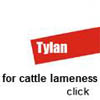NADIS Cattle Report Forecast – April 2006
NADIS is a network of 40 veterinary practices and six veterinary colleges monitoring diseases in cattle sheep and pigs in the UK. NADIS data can highlight potential livestock disease and parasite incidence before they peak, providing a valuable early warning for the month ahead. |
NADIS disease forecasts are written specifically for farmers, |
ADULT CATTLE
Metabolic disease
The number of cases of displaced abomasums (DAs) increased significantly in February, but still remained less than last year. March to May is the peak period for DAs so the next few months will be the real test for whether the number of DAs remains below the average of the last 4 years.
Figure 1: Comparison of the number of displaced abomasum cases so far this winter with the mean of the previous four years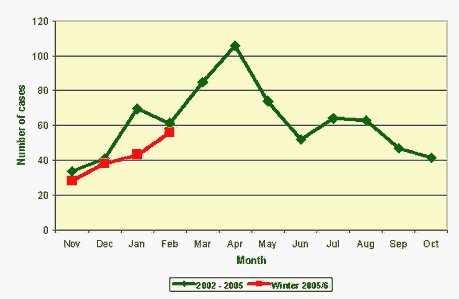
Acetonaemia and DA are often linked together, with both diseases associated with sub-optimal management of the dry and freshly calved cow. Indeed both follow similar seasonal patterns with peaks around April. Yet, although DA reports have increased by over 300% in comparison to 1997-2001, acetonaemia cases have increased by only 50% (Figure 2).
Figure 2: Comparison of the change in the number of reports of displaced abomasum from 2002 to 2005 compared to that of acetonaemia cases.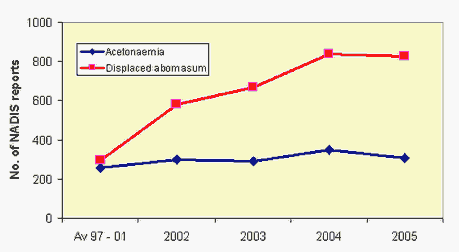
So whereas the two diseases had a similar incidence in 1997-2001, DA is now significantly more common. As figure 3 shows, although the increase in DAs is throughout the year, the biggest increase in DAs in comparison to acetonaemia is in late winter / early spring, again confirming that there are risk factors present in spring which significantly increase the risk of DAs but not acetonaemia.
Figure 3: Monthly comparison of the ratio of displaced abomasum to acetonaemia cases for the years 1997 to 2001 and 2002 to 2005
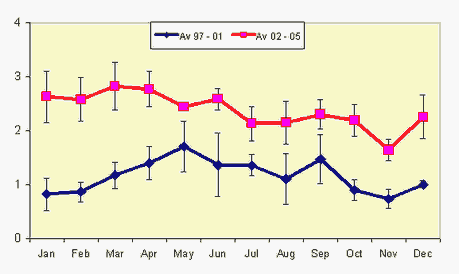
Fertility
The number of reports of anoestrus, ovarian cysts and non-detected oestrus were all lower in February than average, with the number of reports of both ovarian cysts and anoestrus being the lowest February figure since NADIS records began in 1997, and non-detected oestrus being less common than any year except 2004. Does this mean that the relatively warm and very dry winter combined with the availability of good forage has reduced the levels of these nutritionally-linked problems or is it a reflection of the current financial situation on-farm? We would be very interested to hear
Figure 4: Monthly reports of non-detected oestrus for May 2005 to February 2006 compared to the average for 1997 to 2004.
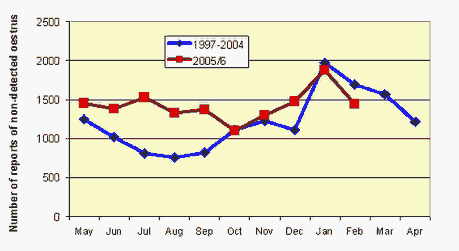
Lameness
The NADIS reports show no increase in lameness treatment rates for February, indeed overall lameness treatment reports fell by 33% compared to January. As with anoestrus and ovarian cysts, the figures reported in February were the lowest ever reported by NADIS. So clearly the benefit of the dry weather is far outweighing any effect of the loss of the OTMS. The risk of large numbers of unproductive lame cows later in the year still remains.
Figure 5: Reports by NADIS vets of all cases of lameness for 2006 (up to February), all of 2005 and the average for 1997 – 2004)
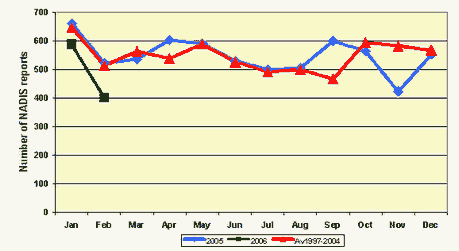
One interesting lameness problem reported by a NADIS vet involved a farm with a problem of soft soles and bruising. The cause was thought to be poor design of the feeding area which had a high step from the feed passage onto the concrete behind. This meant that cows tended to stand with their back feet on the ground and their front feet in the feed passage, increasing the pressure on the hind feet. This was then made worse by the use of a flush system to clean the concrete behind the feed passage which resulted in wet soft hind feet which were more susceptible to bruising.
CALVES
The number of calf scour outbreaks reported has been low so far this year with February seeing a slight decline from January’s very low levels. However last February the levels were similar and the spring season had significantly more cases than average. So a focus on calf scour now could prevent similar changes this year, particularly as current forecasts suggest that the end of March and April will be warm and wet.
Figure 6: Comparison of NADIS reports of calf scour outbreaks in 2005 and 2006 with the average number of monthly reports for 1997 to 2004
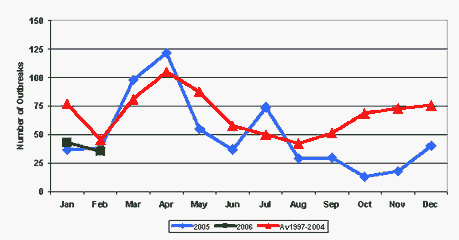
Richard Laven PhD BVetMed MRCVS
Copyright © NADIS 2006 www.nadis.org.uk
| FURTHER INFORMATION | SPONSORS’ LINK |
| • To find out more about lungworm, click here |
|
| FURTHER INFORMATION | SPONSORS’ LINK |
| • To find out more about cattle lameness click here |
| FURTHER INFORMATION | SPONSORS’ LINK |
| • Supporting British Livestock click here |
|


